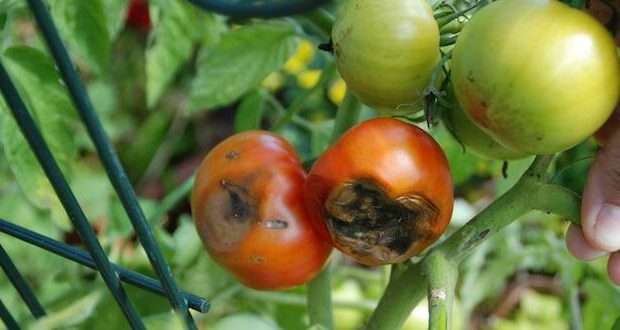SMALL SPACE GARDENING: Tomato troubles in the backyard garden

Blossom end rot on tomatoes is due to a calcium deficiency often caused by fluctuations in soil moisture. (photo courtesy of www.MelindaMyers.com)
 by Melinda Myers
by Melinda Myers
Extreme heat, drought, torrential rains, and hungry critters may be wreaking havoc on your garden. After weeding, watering, and waiting you may be finding less, diseased, or misshapen tomatoes. Don’t give up. Make a few adjustments in garden maintenance to boost the current and future tomato harvests.
Blossom end rot is a common problem on the first set of fruit. It’s due to a calcium deficiency often caused by fluctuations in soil moisture frequently seen on the first set of fruit and those grown in containers.
Always water thoroughly to encourage a deep robust root system. Adjust your watering as needed and mulch the soil to help keep it consistently moist. Have your soil tested before adding any calcium fertilizer. Further reduce the risk of blossom end rot by avoiding root damage when staking and cultivating your garden. Eliminating some of the roots limits the plant’s ability to absorb water and nutrients. Avoid overfertilization and don’t use ammonium-based nitrogen fertilizers on tomatoes.
Fortunately, it is safe to eat the firm red portion of the affected tomato. Since this is a physiological disorder, not a disease or insect problem you can cut off the black portion and toss it into the compost pile.
Cracked fruit is also common in the garden. Fluctuating temperatures, moisture stress, and improper fertilization result in irregular development of the fruit that results in cracking. You can’t change the weather, but you can reduce the risk of this problem with thorough, less frequent watering to encourage deep roots. And just like blossom end rot, mulch the soil to keep it evenly moist and be sure to avoid root damage.
Several fungal diseases, such as early and late blight, septoria leaf spot, and anthracnose, can cause spots on the leaves and fruit of tomatoes. Minimize the problem by rotating your plantings whenever possible. Move your tomatoes to an area of the garden where unrelated crops, such as beans, lettuce, or onions, had been growing the previous season.
Mulching the soil also helps keep soil-borne fungal spores off the plant. Water early in the day and if possible, apply the water directly to the soil with a soaker hose, drip irrigation, or a watering wand to reduce the risk of disease.
Properly space and stake or tower your tomato plants to promote healthier growth and reduce the risk of disease. Remove any volunteer tomatoes that sprout and crowd out the current season’s planting.
Remove weeds as they appear. Many serve as hosts for insect pests and diseases and compete with tomato plants for water and nutrients. Removing them before they flower and set seed eliminates hundreds of weeds you would need to pull next year.
Always clean up and dispose of disease-infected plant material in the fall. Cultural practices and growing the most disease-resistant varieties available are often enough to keep these diseases under control.
If you choose to use a fungicide, select one labeled for food crops and apply it at the first sign of the disease. Repeat applications are usually needed. Be sure to read and follow all label directions carefully whether using organic, natural, or synthetic fungicides.
Enjoy this year’s harvest and continue to make any needed changes now and in the future to boost your gardening success. And as a gardener you know there is always next year.
Melinda Myers has written more than 20 gardening books, including the recently released Midwest Gardener’s Handbook, 2nd Edition, and Small Space Gardening. She hosts The Great Courses “How to Grow Anything” instant video and DVD series and the nationally syndicated Melinda’s Garden Moment TV & radio program. Myers is a columnist and contributing editor for Birds & Blooms magazine and her website is www.Melinda Myers.com.
Responsible journalism is hard work!
It is also expensive!
If you enjoy reading The Town Line and the good news we bring you each week, would you consider a donation to help us continue the work we’re doing?
The Town Line is a 501(c)(3) nonprofit private foundation, and all donations are tax deductible under the Internal Revenue Service code.
To help, please visit our online donation page or mail a check payable to The Town Line, PO Box 89, South China, ME 04358. Your contribution is appreciated!


Leave a Reply
Want to join the discussion?Feel free to contribute!